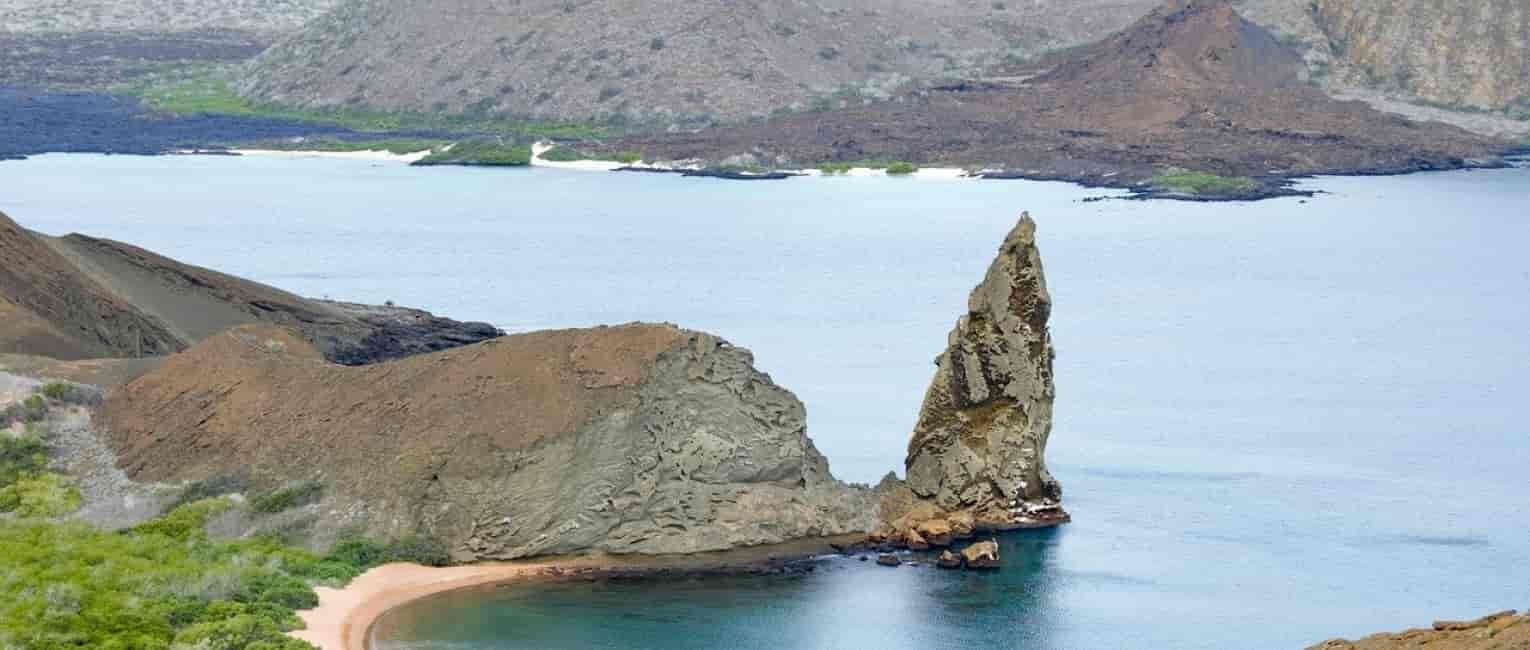
Galápagos Islands Wildlife Travel Guide
The Galápagos Islands are one the last remaining places on Earth where the human footprint is still at a minimum.
There is no place in the world quite like it. The Galápagos archipelago is around 1000km from Ecuador and is made up of 125 islands and islets. Ecuador has committed a lot to the conservation of the islands and their animal species to ensure that tourism does not begin to degrade the environment there. The islands boast some of the best-preserved natural habitats in the world, and their wildlife is the stars of the show On your Galápagos islands vacation, you will encounter wildlife within the first few minutes of arriving, in the form of a sea lion wandering the street, birds singing from the treetops, or curious dolphins in the water.
The islands offer a one-of-a-kind unique travel adventure where you can experience nature hands-on at its richest and most exotic.
How Did The First Animals Arrive On The Galápagos Islands?
Before we talk about the types of Galápagos wildlife you are going to meet on the islands, It's just as exciting to find out the story of how wildlife came to be on the islands. One of the most amazing facts about the islands is they were initially formed from molten rock. So the islands started as a volcanic wasteland that built themselves up out of the ocean over time, which needless to say was not very habitable. The Galápagos Islands are also not particularly accessible as they are almost 1000km from the nearest landmass.
Wildlife is thought to have appeared on the islands traveling on clumps of vegetation or wood that came adrift from the mainlands. And over thousands of years have evolved into wonderful and unique species many of which can only be found only at the Galápagos.
What Animals Can Be Found on the Galápagos Islands?
For wildlife lovers, a trip to the Galápagos is a trip of a lifetime with so much to discover. There are almost 9,000 recorded species on the islands and here you will find animals endemic and native to the Galápagos meaning you will only find them here and nowhere else on the planet. The islands were left isolated and species have been left to evolve for long enough that they have not developed a fear of human visitors and are often quite curious and playful with tourists.
From pink iguanas and purple crabs to birds with blue feet and the only penguins in the Northern Hemisphere. Here are just some of the amazing Galápagos wildlife you can find on your trip. Let's dive in and have a look at the reptiles of the Galápagos.
Galápagos Islands: Reptiles
Land Iguana
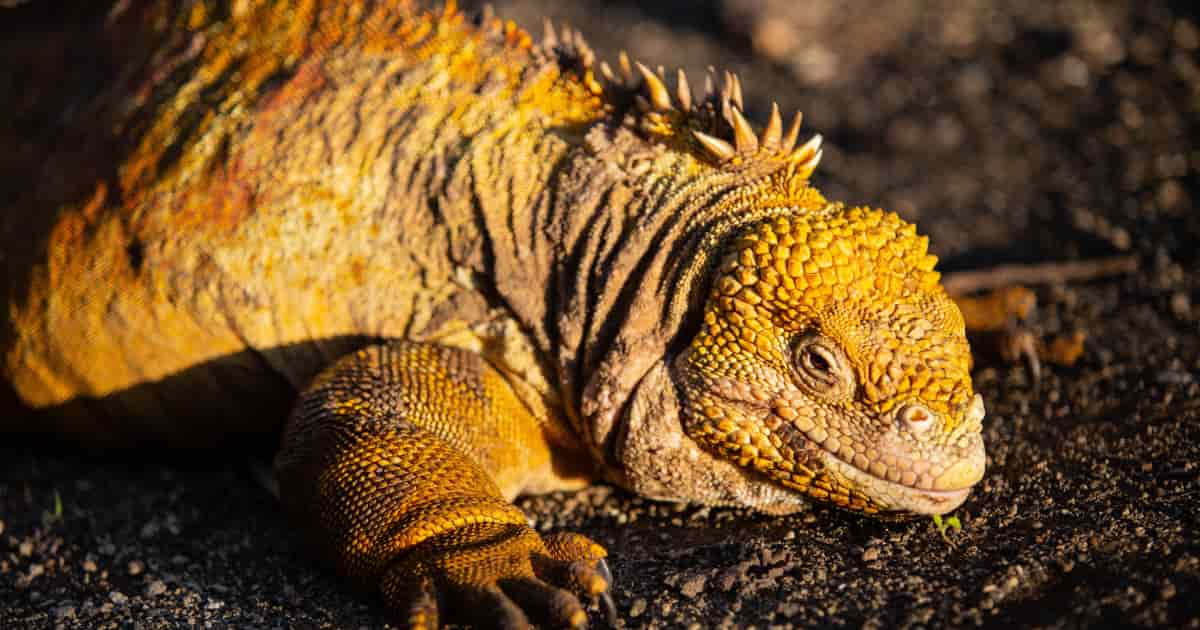
The yellow land iguana has a slightly unusual appearance due to the spiky crests on its head along with its yellow colouring and seemingly smiling faces. They can grow over 1m in length, can weigh around 13kg. But despite their rather intimidating appearance and size they are mainly herbivores and even have a mutual friendship with the finches which are birds found on the islands. The finches will groom the iguanas by picking ticks from their scales and the finches get free food. So from a distance, you might notice a bird riding on the back of an iguana. And this is one of the least stranger sights you will come across on the islands.
This iguana is one of the three types of land iguanas endemic to the islands.
Where to find:
The female land iguana lays its eggs in the hot volcanic sands. This is one of the reasons they are mainly found in Fernandina. Fernandina island lies just above the volcanic hotspot that was responsible for the creation of the islands. You will also come across them in Santa Cruz, Santiago, and North Seymour.
Santa Fe Iguana
Many islands develop their own subspecies because of the wildly different characteristics and living conditions of each island. The Santa Fe iguana is a perfect example of this. The Santa Fe iguana has a stronger yellow colouring to the land iguana and an even more spiky appearance. Also similar in behavior they also share a mutual friendship with the finches on the island.
Where to find:
Named after its home, you will find them on the Santa Fe island. When on the lookout for these Iguanas you will find them happily basking in the sun or feeding off the prickly-pear cactus.
Nothing gets these iguanas more excited than the yellow flowers of the genus Portulaca. When this plant is in season you will generally find them nearby happily munching on its yellow flowers.
Pink Land Iguana
Also worth mentioning as they are not just a different colour to the typical land iguanas, but also an entirely different species. They are one of the Galápagos' most recently classified species as for many years they were passed off as an oddity of the regular iguana.
Pink land iguanas can only be seen on the slopes of Wolf Volcano in the north of Isabela Island which is off-limits to tourists as this is an active volcano that only went off as recent as 2015/2016. But these extraordinary creatures are certainly worth finding out about as they have a remarkable story of surviving on an active volcano and are thought to be one of the oldest reptiles on the planet. They may have even arrived 5.7million years ago!
Lava Lizard
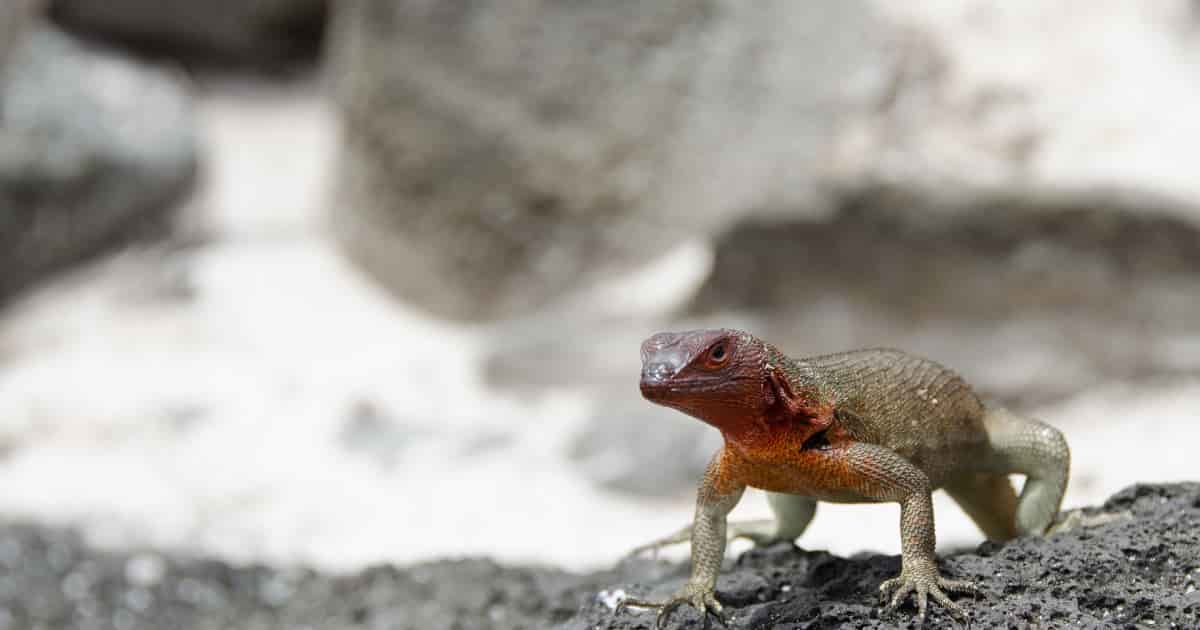
One of your most common friends on the islands. There are several species of lava lizards and the best news is they are very friendly creatures to tourists and seemingly love the attention. With beautiful and varied fire coloured scales, they are very charismatic creatures and each island will have its own species varying in colour.
You will undoubtedly see many lava lizards everywhere you travel on your trip to the Galápagos islands and they are generally quite cute and friendly.
If you are lucky enough you may even catch a push-up competition! Because of their natural push-up stance lava lizards tend to assert their dominance to other males over their territory and do this to appear larger and more menacing to a competitor.
Where to find:
Lava lizards can be found on all islands and it would be quite surprising if you didn’t come across them almost everywhere you explore.
Galápagos Islands: Birds
There is thought to be 56 species of birds on the Galápagos Islands, with 46 of these native to the Islands and not found anywhere else in the world. The cool waters surrounding the islands are rich in nutrients providing the perfect diet for many seabirds. The thousands of miles of open oceans and cliff sides are also perfect for nesting.
Inland there are 29 species of birds, with 21 species unique to the Galápagos.
Traveling through the Galápagos Islands offers a bird-watching opportunity of a lifetime. It is easy to be captivated by the array of different species as you travel through the islands.
Before we start here is a useful list of all the birdlife on the islands you might need on your travels Galápagos Bird Checklist
Let's first talk about the popular land birds.
Finches
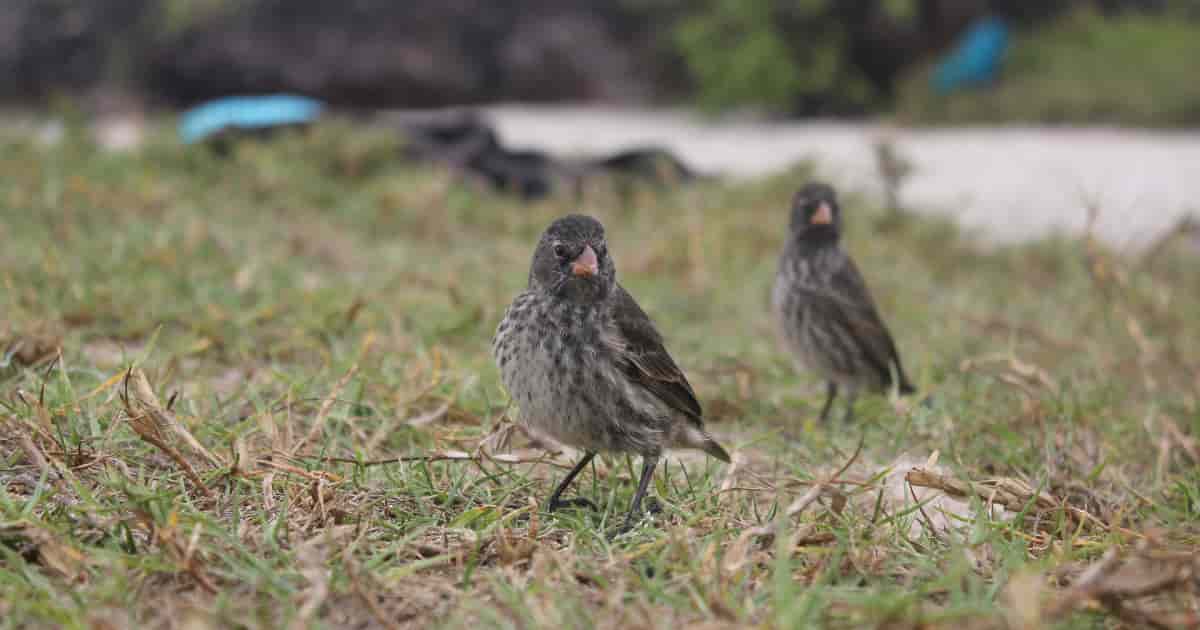
Or know to many as Darwins Finches. These birds are an ancestor of the finch and have evolved to become their own species unique to the Galápagos. These birds famously evolved to have different colours and also different beaks depending on the island they inhabit. So keep a lookout on each island to find the different finches you can encounter and see can you spot them all!
Where to find:
Darwins Finches are found on each of the islands but will have a different colour and different beak shape depending on where you see them.
Learn more detail about the different finches you might encounter so you know which guys you are meeting on your island travels.
Frigate Bird
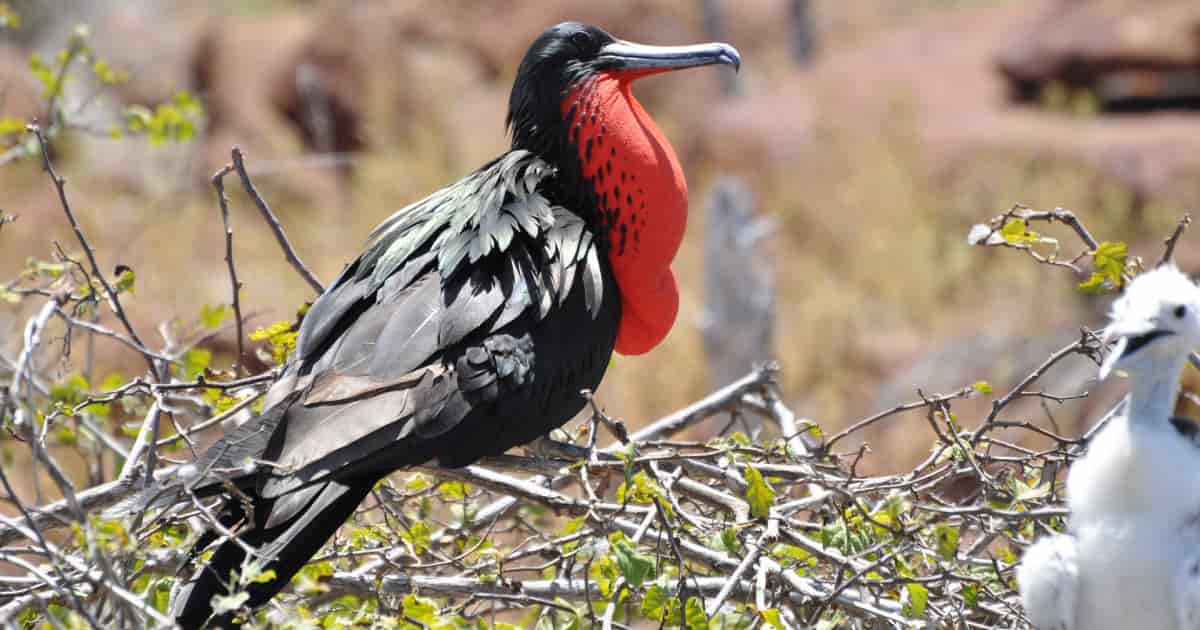
The frigate bird can be seen in many locations across the world but 2 species are native to the Galápagos Islands which are the Great Frigate and Magnificent Frigate birds.
One of the most impressive inhabitants of the islands, the Frigate bird has a body up to 45 inches long with a huge wingspan to match.
During mating season the male Frigate bird can be seen to puff out its chest to attract a female mate. Which can make for some spectacular pictures.
Where to find:
The Frigate bird is present all year round and your most likely encounter is seeing one follow your boat as it heads out to sea to feed.
There are colonies of frigate birds on a number of islands such as North Seymour Island, Floreana Island, San Cristobal, and Genovesa island. With the magnificent frigate usually spending much of its time around North Seymour Island.
Vermillion Flycatcher
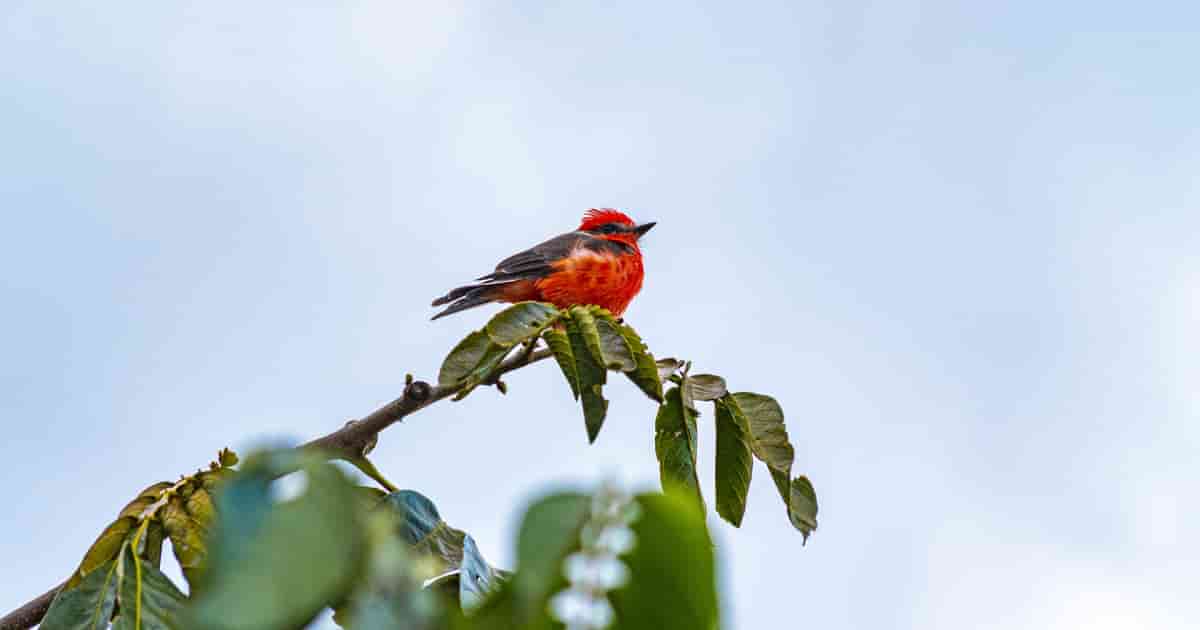
A favourite with tourists that can be found at most locations. The vermillion flycatcher is a very charismatic songbird with beautiful colouring making them both eye-catching and easy on the ears.
The male birds have a very bright red plumage on their chest while females have more of a light chocolate brown colour and yellow plumage.
Where to find:
Vermillion Flycatchers can be easily spotted on Isabela Island, Fernandina and Rabida and sometimes on Santa Cruz. They are mostly seen from January to May during their nesting season and when the highlands are lush with vegetation. When near a water source have a listen out for their songs “Peet a weet a weet, Peet-Peet”
They have sadly become extinct on the islands of San Cristobal and Floreana and are being sighted less and less on Santa Cruz.
Yellow Warbler
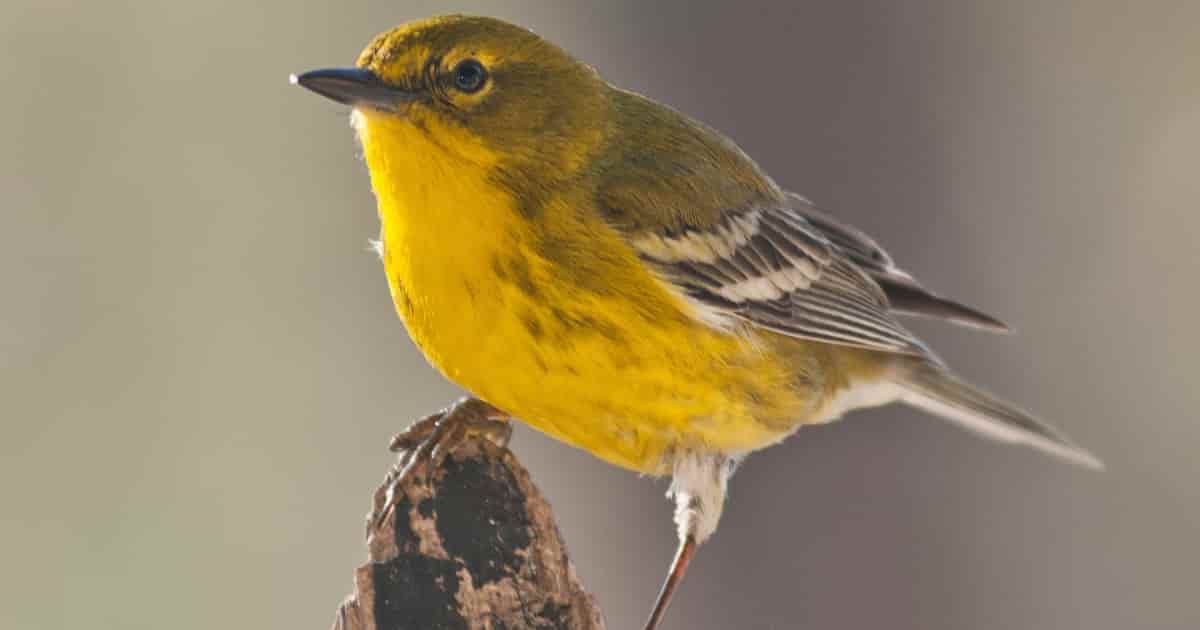
Not unique to the Galápagos, but this stunning yellow coloured bird is always a stand-out for visitors with its bright plumage and melodious singing. These birds have a wide range of melodies that they sing that can be easily distinguished from other birds and are very pleasant to listen to.
Where to find:
The yellow warbler can be found throughout most locations and are quite common to see on your travels. If you don’t see their bright yellow plumage you will certainly find yourself captivated by their soothing melodies.
Galápagos Islands: Sea Birds
With an estimated 750,000 sea birds inhabiting the Galápagos Islands you are certain to come across all types of iconic and unique species on your travels. Many of the seabirds you encounter on your travels are not endemic to the Islands here, but are very popular amongst travelers due to their iconic looks, interesting behaviors, and surprising tameness making them a pleasure to watch and experience anywhere you go.
Blue Footed Boobies
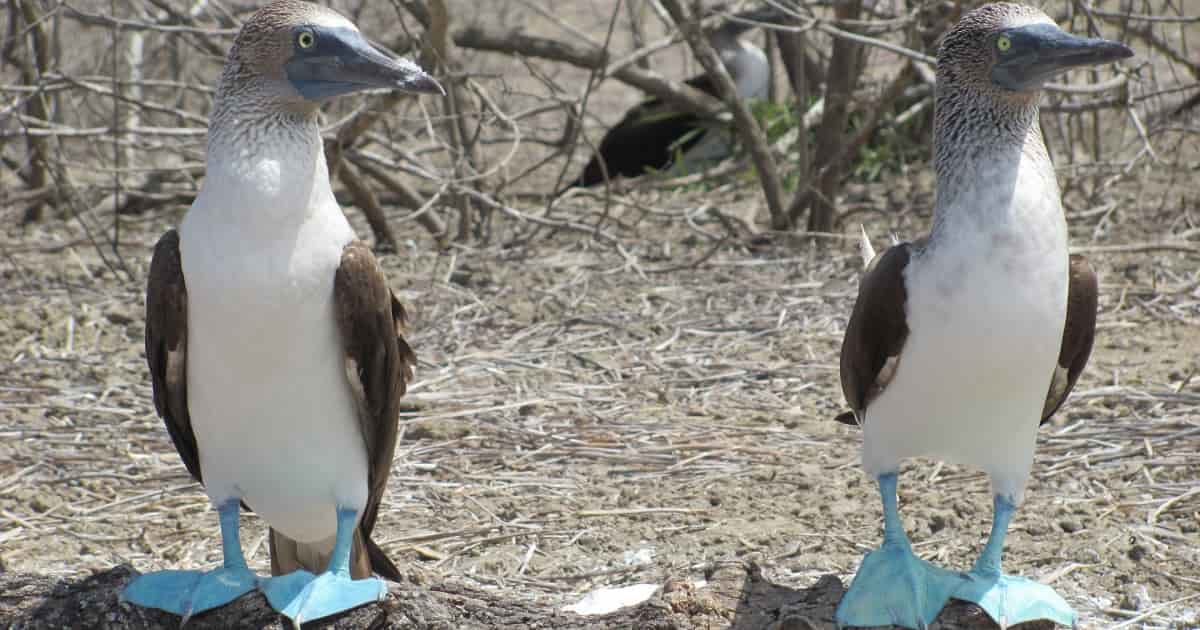
Blue-footed boobies are one of the most iconic of all birds here. Stunning to watch as they make their spectacular dives into the sea and if you are lucky you may witness the blue-footed booby dance, a quirky mating ritual where the male struts to attract a mate.
Their name comes from the Spanish term “Bobo” meaning clown, so you are certain to find some entertainment from the blue-footed boobies on your travels which is often one of the highlights of many trips.
Where to find:
Blue-footed boobies are typically found on North Seymour Islands and Espanola but can be seen across all islands. You will see them most populated around March to June, and if you are lucky enough to catch them during these months when they are out to mate you may find yourself witnessing the popular blue-footed booby dance.
Red Footed Boobies
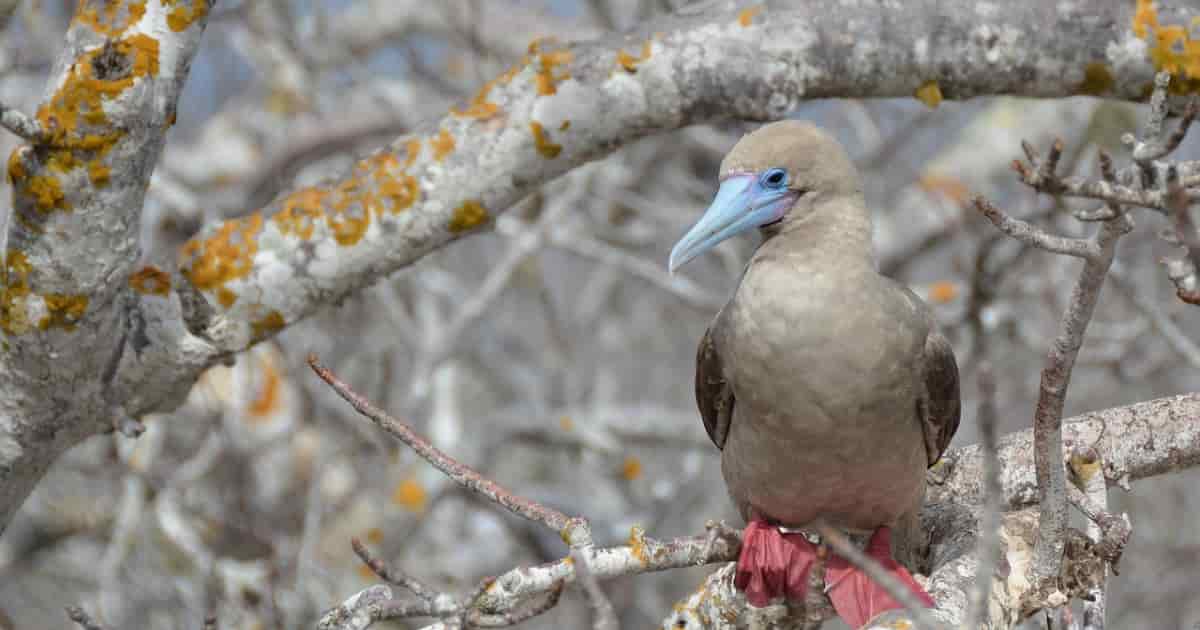
Another of the iconic sea birds, the red-footed booby can be seen in both brown and white colour with their red feet and pointed beaks. They are known locally as ‘Piquero’ which means Lancer, due to their fishing technique and pointed beaks.
During mating season they will point their beaks to the sky and wave their bright red feet around on a tree branch. The male with the brightest red feet stands the best chance of finding a mate.
They are generally quite friendly birds, and while they may not approach passing travelers, they have been known to stop by on passing boats for a rest when out fishing.
Where to find:
They are mainly found on Seymour, San Cristobal, and Genovesa islands and will often be seen out at sea.
Nazca Boobies
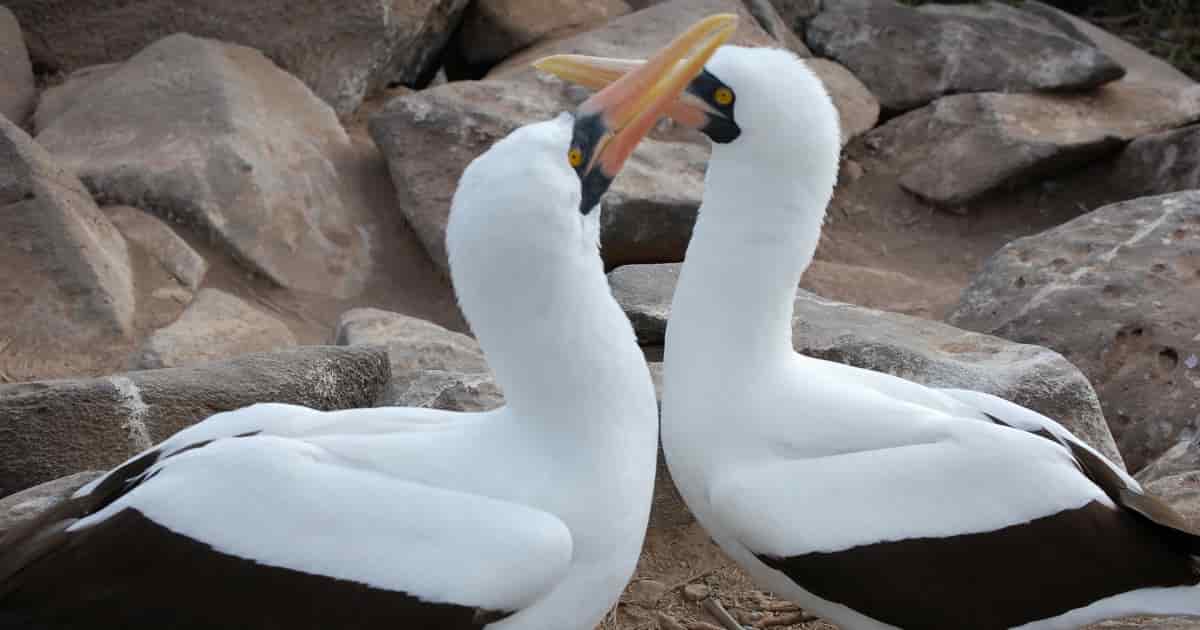
The Nazca booby can be differentiated from other booby species as they do not have the iconic bright coloured feet. However, they can be just as spectacular to watch as they are the largest of the booby species and can plunge down towards the water from up to 30 meters.
They have their own unique courtship ritual which involves the male pointing to the sky with their beaks and shaking their head up and down. When they have finished their routine the female will then join in and knock their beaks together with the males.
Where to find:
The nazca boobies are most commonly seen on Espanola, San Cristobal, Genovesa and Punta Suarez. They lay their eggs between November and February which are the best times to get a closer look at them but can typically be seen throughout the year.
Galápagos Islands: Marine Wildlife
Galápagos Sea Lion:
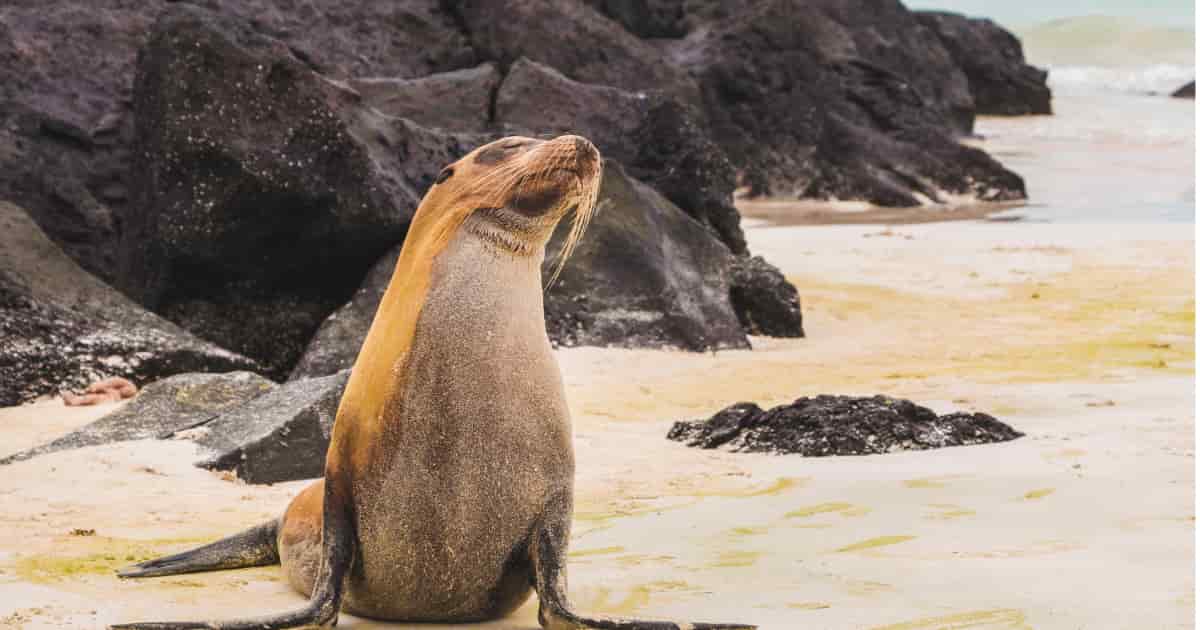
When you arrive you won't have far to go before you meet one of the popular sea lions. Quite social and curious and often found playing or lazily lounging around the beaches and docks throughout the islands. They can be heard by their bark which is very similar to a dogs bark.
Young sea lions absolutely love playing in the water with visitors, particularly when out snorkeling. The highlight of any trip to the Galápagos Islands is snorkeling and swimming with the sea lions.
Although very playful, the males can be very territorial during mating season which lasts between December and May.
Where to find:
You will find Sea Lions on almost all of the shorelines. If you are visiting between May to November there is a very good chance of coming across and even swimming with some of the baby pups.
An opportunity to go snorkelling with the Sea Lions will be a moment to never forget.
Galápagos Penguin
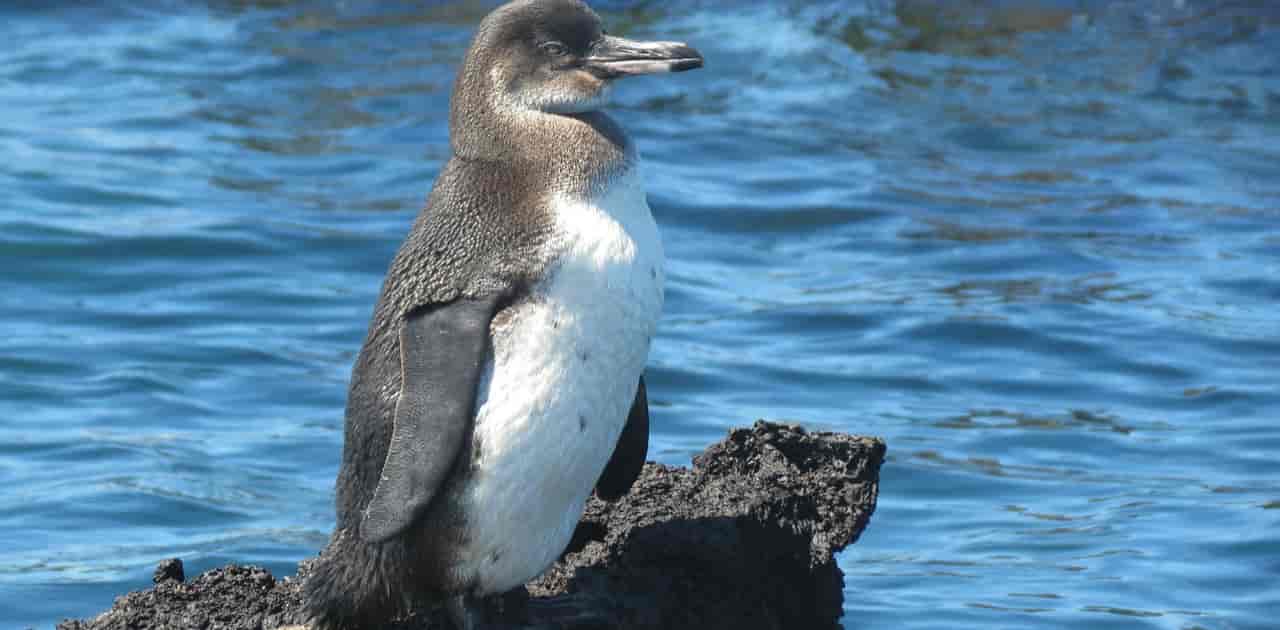
The Galápagos penguin is the only species of penguin to visit the northern hemisphere.
They are the 2nd smallest species of penguins and you won’t see them anywhere else in the world as these species have adapted to the temperate climate.
They arrived around 4million years ago and decided to stay because the Galápagos seas are rich in fish and nutrients. Naturally, penguins are more suited for colder climates but the Galápagos penguins have adapted and evolved for the islands which is why they are much smaller, shedding their excess body fat that was no longer needed.
You may see them sometimes hunched over in a strange position – They do this to keep cool and avoid sunburn on their delicate feet.
When swimming and hunting for food they can reach speeds of up to 35km/h. If you have the opportunity to go snorkeling, keep an eye out for these little guys speeding past you underneath the water.
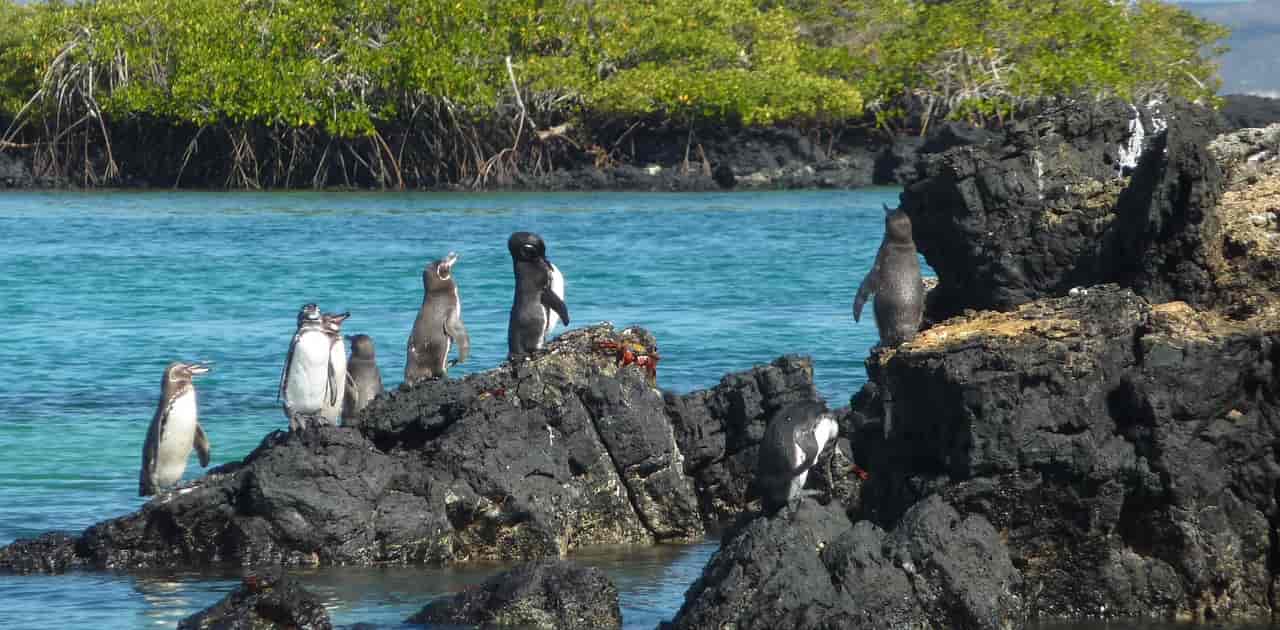
Where to find:
The majority of Galápagos Penguins live on and around the islands of Fernandina and Isabela Islands – but can also be seen on Santiago, Bartolome, Santa Cruz and Floreana.
Sally Lightfoot Crab
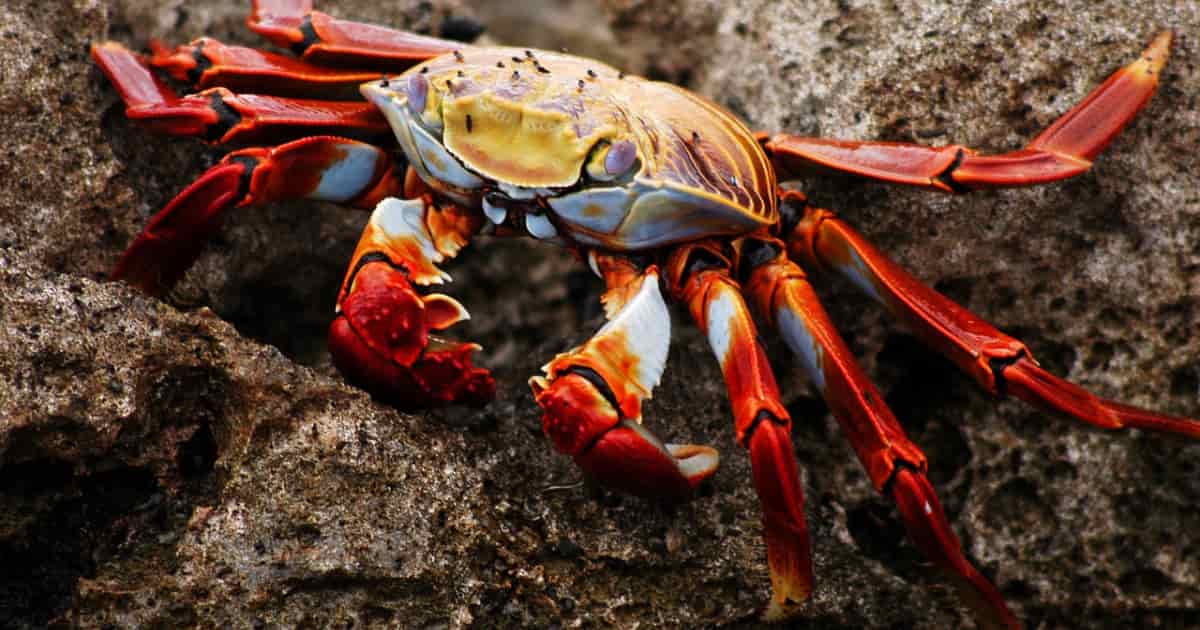
The sally lightfoot crab is a very popular and vibrant character.
With their bright red shell with yellow and blue shades, it’s hard to miss these popular creatures on the shorelines. There is more to these incredible-looking crabs than meets the eye, as you may notice they have 10 legs that allow them to move in four different directions with incredible agility.
Their amazing agility even allows them to skip across the water for short distances.
As babies, the sally lightfoot crab has a darker shell allowing them to blend in with rocks to hide from predators and as they become older their shell hardens. When their shell hardens it becomes brighter and more vibrant, so you can tell a sally lightfoot crabs age by the color of their shell.
Where to find:
Sally Lightfoot crabs can be seen on all of the Islands, just keep a lookout near all shorelines, shallow waters, and water pools you come across and you will be sure to spot their bright colors at any time throughout the year.
Galápagos Marine Iguana
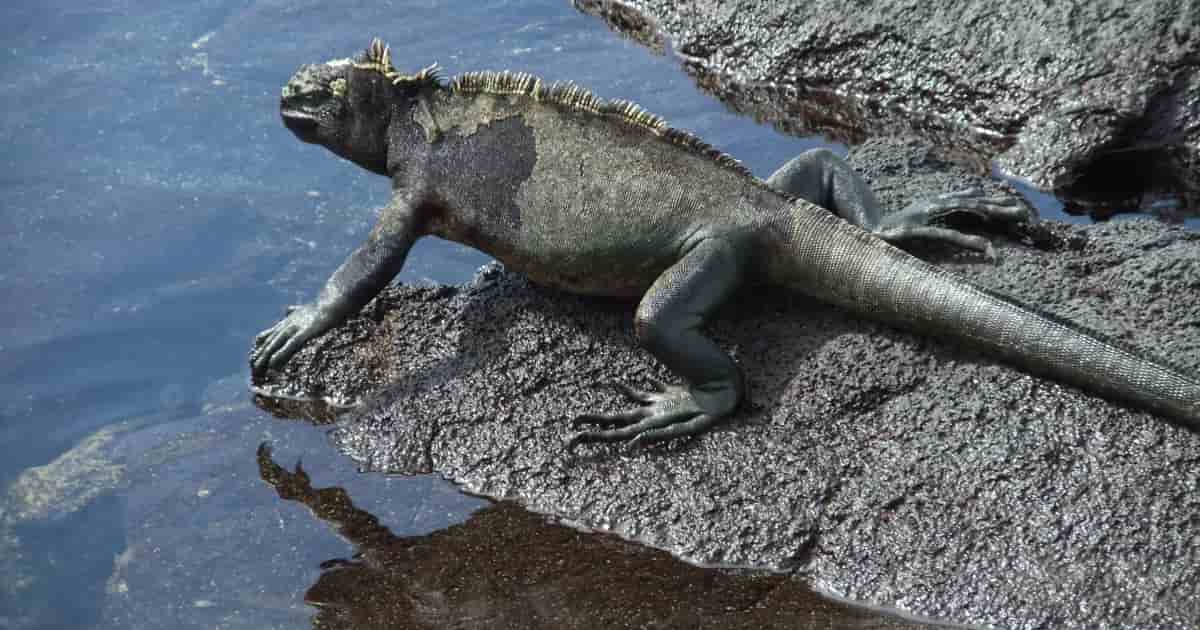
The marine iguana is the only marine lizard species in the entire world and can only be seen at the Galápagos. There are seven subspecies found across the different islands and can be found in different sizes and even color. They are quite a common sight on the Galápagos and very popular with visitors.
Like most reptiles, they are ectothermic and need to regulate their body heat in order to survive and perform certain activities such as eat and travel. They will warm up in the sun during the day by lying flat to maximise the amount of heat they are receiving. So when you first spot one they may seem like lazy creatures, but they are essentially recharging their batteries.
They generally have black bodies but change their colouring during mating season, showcasing green, yellow, and red colorful patches.
Where to find:
The Galápagos marine iguana can be found on all the islands. However, on San Cristobal you will find the largest marine iguana, measuring over 1 meter in length.
Galápagos Tortoise
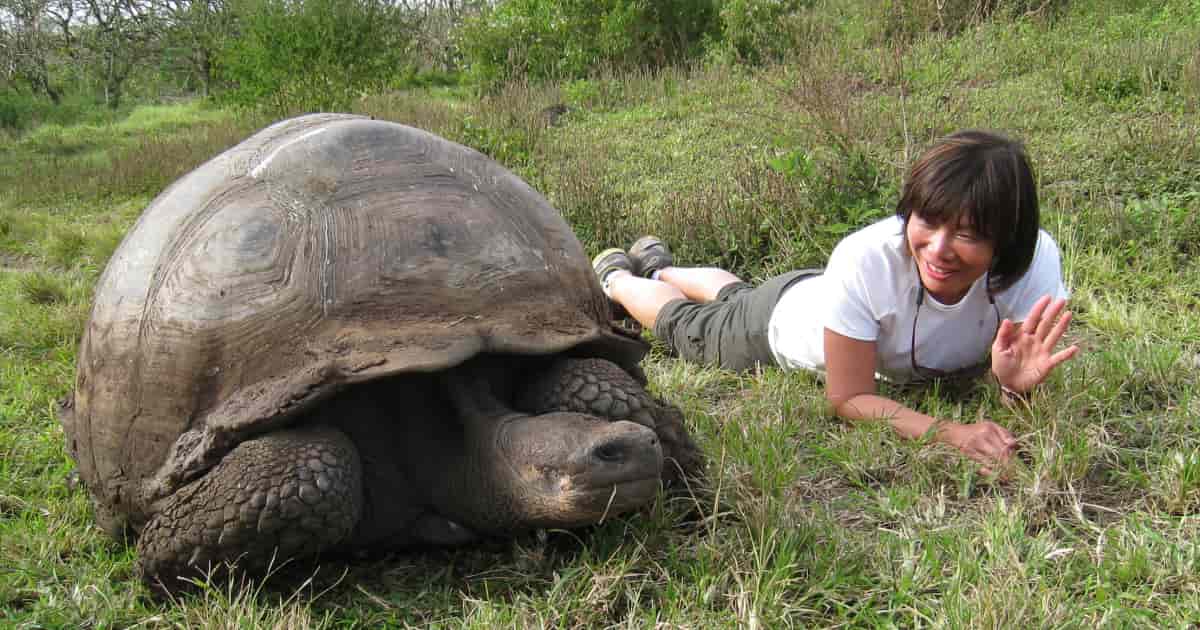
Probably the most famous of all animals of the Galápagos Islands. They may be found and bred in other parts of the world, but here is where they call home
In fact, while most of the endemic wildlife found here are named after the islands, the tortoise was actually the inspiration of the name Galápagos.
When the islands were discovered by Spanish explorers in the 1500’s they came across these tortoises everywhere and even used them to travel around on their backs. Before learning this is actually incredibly bad for the tortoise, they called them “Galapago” which was the old Spanish word for Saddle.
They are incredibly large and are known as the largest tortoise in the world. They can be found between 4-5ft in size and over 500 pounds in weight. For a tortoise of this size, they can move quite far, traveling up to 6km per day during mating season.
Where to find:
You can find the Galápagos Tortoise in six locations. They can be seen on Santa Cruz, Santiago, Espanola, Pinzon, San Cristobal and Isabela Islands.
A trip to Galápagos is never complete without seeing these amazing creatures.
Do’s and Dont’s of Wildlife Spotting
We all want to have amazing moments and even capture that unforgettable photograph but it’s important to know a little bit about each island and the wildlife on it. While our guides are always on hand to help it’s important to know what animal you are encountering and in what habitat at each time of year. Males especially can be territorial during mating season so it’s very important to stay on the paths and tracks of each island and listen to your guide's advice.
There is no flash photography permitted (even on phones) as it could easily spook and wildlife, and chase them off when others are trying to get a peek too.
There are no drones allowed on the islands as they may disturb the birds. Although generally many of the birds are happy to pose and even sing while doing it.
The Galápagos Nation Park (GNP) have a list of 14 important rules to follow on your travels.
Plan Your Trip
To plan your Galápagos islands vacation with us head over to our destination page to learn more about our multi-sport and biking trips to the Galápagos Islands. Download our full trip itinerary to learn more about our 10-day trip and see what plan is right for you.
Come hiking, biking, kayaking, snorkeling and discover the islands on a unique trip and experience unforgettable moments and stories with the locals and island wildlife.
What will your Galápagos adventure be?
If you can't get enough of the Galápagos, be sure to check out our 10 bizarre facts about the Galápagos Islands to learn more about lonesome George, the abnormal colliding currents and other amazing and strange facts about the wildlife of the islands.
Happy Travels,
Trish Sare.
About The Author
 Trish Sare is the owner of BikeHike and a passionate outdoor enthusiast with over 30 years of experience as a world traveler. She's lived, traveled, and guided extensively in North, South and Central America, Europe, Oceania, Africa, and Asia. She has guided and helped to develop every one of our multi-sport holidays. In her spare time, Trish is usually outdoors either mountain biking, hiking, sea kayaking, trail running, or climbing. Trish has a passion for the world and all of the amazing cultures that inhabit it and does her best to immerse herself directly into their distinctive lifestyles.
Trish Sare is the owner of BikeHike and a passionate outdoor enthusiast with over 30 years of experience as a world traveler. She's lived, traveled, and guided extensively in North, South and Central America, Europe, Oceania, Africa, and Asia. She has guided and helped to develop every one of our multi-sport holidays. In her spare time, Trish is usually outdoors either mountain biking, hiking, sea kayaking, trail running, or climbing. Trish has a passion for the world and all of the amazing cultures that inhabit it and does her best to immerse herself directly into their distinctive lifestyles.